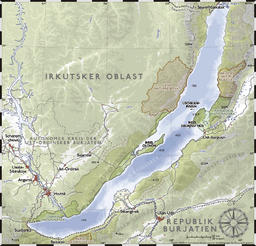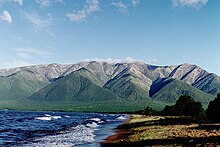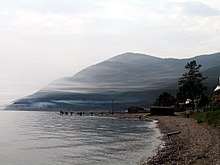Lake Baikal
| Lake Baikal | |
|---|---|
 | |
| Coordinates | 53°30′N 108°12′E / 53.5°N 108.2°E |
| Type | Continental rift lake |
| Primary inflows | Selenga, Chikoy, Khilok, Uda, Barguzin, Upper Angara |
| Primary outflows | Angara |
| Catchment area | 560,000 km2 (216,000 sq mi) |
| Basin countries | Russia and Mongolia |
| Max. length | 636 km (395 mi) |
| Max. width | 79 km (49 mi) |
| Surface area | 31,494 km2 (12,160 sq mi) |
| Average depth | 758 m (2,487 ft) |
| Max. depth | 1,637 m (5,371 ft) |
| Water volume | 23,600 km3 (5,700 cu mi) |
| Residence time | 350 years[citation needed] |
| Shore length1 | 2,100 km (1,300 mi) |
| Surface elevation | 456 m (1,496 ft) |
| Frozen | January–May |
| Islands | 22 (Olkhon) |
| Settlements | Irkutsk |
| 1 Shore length is not a well-defined measure. | |
Lake Baikal (Template:Lang-ru, IPA: [ˈozʲɪrə bʌjˈkɑl], Template:Lang-bxr, meaning "the rich lake"[1]) is in southern Siberia in Russia, located between Irkutsk Oblast to the northwest and the Buryat Republic to the southeast, near the city of Irkutsk. It is also known as the "Blue Eye of Siberia". It contains more water than all of the North American Great Lakes combined.[2][3]
At 1,637 meters (5,371 ft), Lake Baikal is the deepest lake in the world,[4] and the largest freshwater lake in the world by volume.[5] However, Lake Baikal contains less than one third the amount of water as the Caspian Sea[citation needed], which is the largest lake in the world. Like Lake Tanganyika, Lake Baikal was formed as an ancient rift valley, having the typical long crescent shape with a surface area of (31,494 km2 (12,160 sq mi)*), less than that of Lake Superior or Lake Victoria. Baikal is home to more than 1,700 species of plants and animals, two thirds of which can be found nowhere else in the world[6] and was declared a UNESCO World Heritage Site in 1996.[7] At more than 25 million years old, it is the oldest lake in the world.[5]
A Russian mini-submarine attempting to set a record for the deepest freshwater dive on July 29, 2008, was originally reported as being successful, but a correction later emerged that reported the MIR I[clarification needed] failed to do so, reaching a depth of only 1,580 meters (5,180 ft).[8]
Geography and hydrography



Lake Baikal was known as the "North Sea" in historical Chinese texts. It was situated in the then Xiongnu territory and very little was known about the lake, until the Trans-Siberian railway was built between 1896 and 1902. The scenic railway loop encircling Lake Baikal required 200 bridges and 33 tunnels. As it was being built, a large hydrogeographical expedition headed by F.K. Drizhenko produced the first detailed atlas of the contours of Baikal's depths. The atlas demonstrated that Lake Baikal has more water than all of North America's Great Lakes combined — 23,600 cubic kilometers (5,700 cu mi), about 20% of the total unfrozen fresh surface water on the earth.Known as the "Galápagos of Russia", its age and isolation have produced some of the world's richest and most unusual freshwater fauna.[5]
Lake Baikal is in a rift valley, created by the Baikal Rift Zone, where the crust of the earth is pulling apart.[3] At 636 kilometers (395 mi) long and 79 kilometers (49 mi) wide, Lake Baikal has the largest surface area of any freshwater lake in Asia (31,494 km2 (12,160 sq mi)*) and is the deepest lake in the world (1,637 m (5,371 ft)*). The bottom of the lake is 1,371 meters (4,498 ft) below sea level, but below this lies some 7 kilometers (4.3 mi) of sediment, placing the rift floor some 8–9 kilometers (more than 5 miles) below the surface: the deepest continental rift on Earth.[3] In geological terms, the rift is young and active—it widens about two centimeters per year. The fault zone is also seismically active; there are hot springs in the area and notable earthquakes every few years. The lake drains into the Angara tributary of the Yenisei.
Its age is estimated at 25–30 million years, making it one of the most ancient lakes in geological history. It is unique among large, high-latitude lakes, in that its sediments have not been scoured by overriding continental ice sheets. U.S. and Russian studies of core sediment in the 1990s provide a detailed record of climatic variation over the past 250,000 years. Longer and deeper sediment cores are expected in the near future. Lake Baikal is furthermore the only confined fresh water lake in which direct and indirect evidence of gas hydrates exists.[9][10][11]
The lake is completely surrounded by mountains. The Baikal Mountains on the north shore and the taiga are technically protected as a national park. It contains 22 islands; the largest, Olkhon, is 72 kilometers (45 mi) long. The lake is fed by as many as three hundred thirty inflowing rivers.[2] The main ones draining directly into Baikal are the Selenga River, the Barguzin River, the Upper Angara River, the Turka River, the Sarma River and the Snezhnaya River. It is drained through a single outlet, the Angara River.
Despite its great depth, the lake's waters are well-mixed and well-oxygenated throughout the water column, compared to the stratification that occurs in such bodies of water as Lake Tanganyika and the Black Sea.
Olkhon, the largest island in Lake Baikal, is the fourth-largest lake-bound island in the world.
Wildlife

The extent of biodiversity present in Lake Baikal is equaled by few other lakes. Lake Baikal hosts 1,085 species of plants and 1,550 species and varieties of animals. More than 80% of the animals are endemic. Epischura baikalensis is endemic to Lake Baikal and the dominating zooplankton species there: 80 to 90 percent of total biomass.[12] The Baikal Seal or nerpa (Phoca sibirica) is found throughout Lake Baikal. It is one of only three entirely freshwater seal species in the world, the other being the two subspecies of freshwater Ringed Seal. Perhaps the most important local species is the omul (Coregonus autumnalis migratorius), a smallish endemic salmonid. It is caught, smoked and then sold widely in markets around the lake.
Of particular note are the two species of golomyanka or Baikal oil fish (Comephorus baicalensis and C. dybowskii). These long-finned, translucent fish normally live in depths of 200 to 500 meters (660–1,640 ft) and are the primary prey of the Baikal seal, representing the largest fish biomass in the lake. They are famous for disintegrating into a pool of oil and bones when exposed to sunlight. The Baikal grayling (Thymallus arcticus baicalensis), a fast swimming salmonid, popular among anglers and the Baikal sturgeon (Asipenser baerri baicalensis), are both important endemic species with commercial value.
Bear and deer are common and hunted along Baikal shores.[citation needed]
Research
- "Miri Na Baykale" redirects here.
Several organizations are carrying out natural research projects on Lake Baikal. Most of them are governmental or associated with governmental organizations. The Baikalian Research Centre is an independent research organization carrying out environmental educational and research project at Lake Baikal.[13]
In July 2008, Russia sent two small submersibles, Mir-1 and Mir-2, to descend 1,592 meters (5,223 ft) to the bottom of Lake Baikal to conduct geological and biological tests on its unique ecosystem. They did not set a world record for the deepest fresh water dive, currently held by Anatoly Sagalevitch, at 1,637 meters (5,371 ft) (also in Lake Baikal aboard a Pisces submersible in 1990).[14][15] Russian scientist and federal politician, Artur Chilingarov, also joined the 60 dives.[16]
Baikal Deep Underwater Neutrino Telescope
Since 1993, neutrino research has been conducted at the Baikal Deep Underwater Neutrino Telescope (BDUNT). The first part of NT-200, the detector NT-36 with 36 optical modules (OMs) at 3 short strings, was put into operation and took data up to March 1995. A 72-OMs array, NT-72, run in 1995–96. In 1996, it was replaced by the four-string array NT-96. Summed over 700 days effective life time, 320,000,000 muon events have been collected with NT-36, -72, -96. The first neutrino events have been selected. Since April 6, 1997, NT-144, a six-string array with 144 OMs, took data in Lake Baikal. NT-200 array is completed in April, 1998. The Baikal Neutrino Telescope NT-200 is being deployed in Lake Baikal, 3.6 kilometers (2.2 mi) from shore at a depth of 1.1 kilometers (0.68 mi). It consists of 192 optical modules (OMs).[17]
Tourism


The lake, called "the Pearl of Siberia", drew investors from the tourist industry as energy revenues sparked an economic boom.[18] Viktor Grigorov's Grand Baikal in Irkutsk is one of the investors, who planned to build three hotels creating 570 jobs. In 2007, the Russian government declared the Baikal region a special economic zone. The popular resort of Listvyanka is home to the seven-story Hotel Mayak. Baikal was also declared a UNESCO World Heritage site in 1996. Rosatom plans to build a laboratory in Baikal, in conjunction with an international uranium plant and to invest $2.5bn in the region and create 2,000 jobs in the city of Angarsk.[19]
Environmental concerns
Baykalsk pulp and paper mill
Baykalsk Pulp and Paper Mill (BPPM) was constructed in 1966, directly on the shore line. The BPPM bleaches its paper with chlorine and discharges the waste into Baikal. After decades of protest, the plant is now closed.[20][21] In March 2009 the plant owner announced the paper mill would never reopen.[2]
Planned East Siberia-Pacific Ocean oil pipeline
Russian oil pipelines state company Transneft[22] was planning to build a trunk pipeline that would have come within Template:M to ft of the lake shore in a zone of substantial seismic activity. Environmental activists in Russia,[23] Greenpeace, Baikal pipeline opposition[24] and local citizens[25] were strongly opposed to these plans, due to the possibility of an accidental oil spill that might cause significant damage to the environment. According to the Transneft's president, numerous meetings with ordinary citizens were held in towns along the route, especially in Irkutsk.[26] However, it was not until Russian president Vladimir Putin ordered the company to consider an alternative route Template:Km to mi to the north to avoid such ecological risks that Transneft agreed to alter its plans.[27] Transneft has since decided to move the pipeline away from Lake Baikal, so that it will not pass through any federal or republic natural reserves.[28][29] Work began on the pipeline, two days after President Putin agreed to changing the route away from Lake Baikal.[30]
Proposed nuclear plant
In 2006, the Russian Government announced plans to build the world's first International Uranium Enrichment Centre at an existing nuclear facility in Angarsk, 95 kilometers (59 mi) from the lake's shores. However, critics argue it would be a disaster for the region and are urging the Government to reconsider.[31]
After enrichment, only 10 percent of the uranium-derived radioactive material would be exported to international customers,[31] leaving 90 percent in the Lake Baikal region for storage. Uranium tailings contains radioactive and toxic materials, which if improperly stored are potentially dangerous to humans and can contaminate rivers and lakes.[31]
References
- ^ Dervla Murphy (2007) Silverland: A Winter Journey Beyond the Urals, London, John Murray, page 173
- ^ a b "Lake Baikal: the great blue eye of Siberia". CNN.com. Retrieved 2006-10-21.
- ^ a b c "The Oddities of Lake Baikal". Alaska Science Forum. Retrieved 2007-01-07.
- ^ "Deepest Lake in the World". geology.com. Retrieved 2007-08-18.
{{cite web}}: Cite has empty unknown parameter:|month=(help) - ^ a b c U.S. Geological Survey Fact Sheet: Lake Baikal — A Touchstone for Global Change and Rift Studies, July 1993 (accessed February 10, 2007) Cite error: The named reference "touchstone" was defined multiple times with different content (see the help page).
- ^ "Russia" Britannica Student Encyclopedia. 2007. Encyclopædia Britannica Online. 3 July 2007 [1]
- ^ "Lake Baikal — World Heritage Site". World Heritage. Retrieved 2007-01-13.
- ^ http://news.bbc.co.uk/2/hi/europe/7530230.stm
- ^ Kuzmin, M.I., et al., 1998. First find of gas hydrates in sediments of Lake Baikal. Doklady Adademii Nauk, 362: 541–543 (in Russian).
- ^ Vanneste, M., et al., 2001. Multi-frequency seismic study of gas hydrate-bearing sediments in Lake Baikal, Siberia. Marine Geology, 172, 1–21.
- ^ Van Rensbergen, P., et al., 2002. Sub-lacustrine mud volcanoes and cold seeps caused by dissociation of gas hydrates in Lake Baikal. Geology, 30(7), 631–634.
- ^ Зоопланктон в экосистеме озера Байкал / О Байкале.ру — Байкал. Научно и популярно
- ^ "Baikalian Research Centre (ANO) (in Russian)". www.lakebaikal.net. Retrieved 2008-07-05.
- ^ Russian news reports (29 July 2008). "Russia claims world-record dive" (web). "Russian scientists say they have broken the world record for the deepest dive in a body of fresh water, plumbing the depths of Lake Baikal in Siberia.". Retrieved 2008-07-29.
{{cite web}}: Cite has empty unknown parameter:|coauthors=(help) - ^ DivingAlmanac.com
- ^ ukpress.google.com/article/ALeqM5iSNtoPecSfX9Qp3Yi4LilKLU1wjA ukpress.google.com/ Submarines to plumb deepest lake
- ^ "Baikal Lake Neutrino Telescope". Baikalweb. 2005-01-06. Retrieved July 30 2008.
{{cite web}}: Check date values in:|accessdate=(help); Unknown parameter|dateformat=ignored (help) - ^ Esslemont, Tom (2007-09-07). ""Pearl of Siberia" draws investors". BBC News. Retrieved 2007-12-04.
- ^ BBC NEWS, 'Pearl of Siberia' draws investors
- ^ Russia Water Pollution
- ^ Sacred Land Film Project, Lake Baikal
- ^ Transneft "Transneft". Transneft. Retrieved 2006-10-21.
{{cite web}}: Check|url=value (help) - ^ "Baikal Environmental Wave". Retrieved 2006-10-21.
- ^ "Baikal pipeline". Retrieved 2006-10-21.
- ^ "The Right to Know: Irkutsk Citizens Want to be Consulted". Retrieved 2007-01-07.
- ^ "Тема: [ENWL] Власти Иркутской обл. выступили против прокладки нефтепровода к Тихому океану". Retrieved 2007-08-03.
- ^ "Putin orders oil pipeline shifted". BBCNews. 2006. Retrieved 2006-10-21.
{{cite web}}: Unknown parameter|month=ignored (help) - ^ "Transneft charged with Siberia-Pacific pipeline construction". BizTorg.ru. Retrieved 2006-10-21.
- ^ "New route". Transneft Press Center. Retrieved 2006-10-21.
- ^ "Work starts on Russian pipeline". BBC News. 2006. Retrieved 2007-12-04.
{{cite web}}: Unknown parameter|month=ignored (help) - ^ a b c Saving the Sacred Sea: Russian nuclear plant threatens ancient lake

